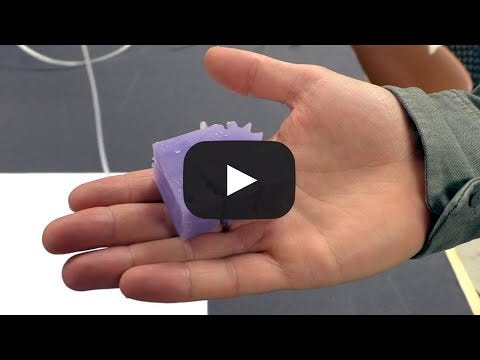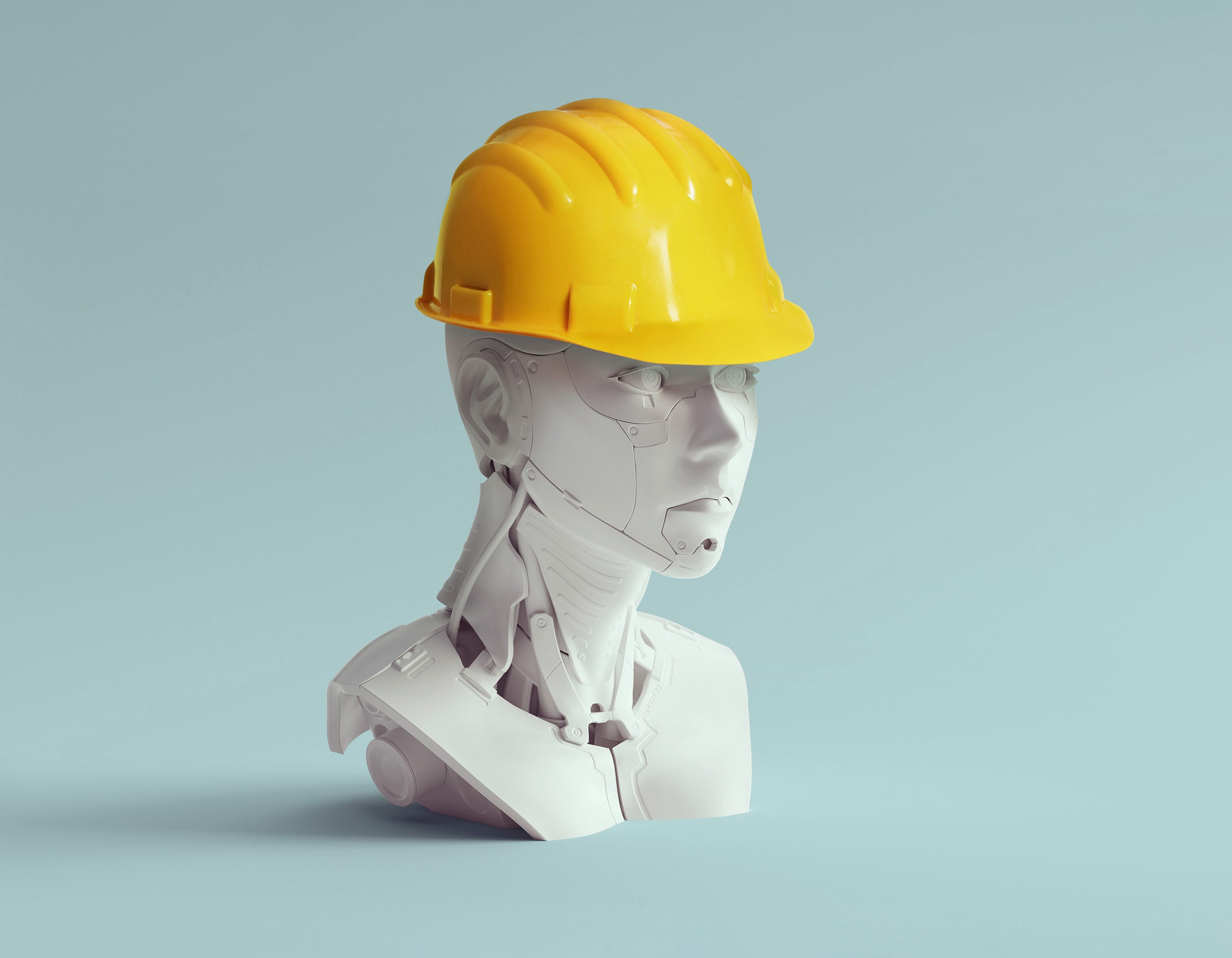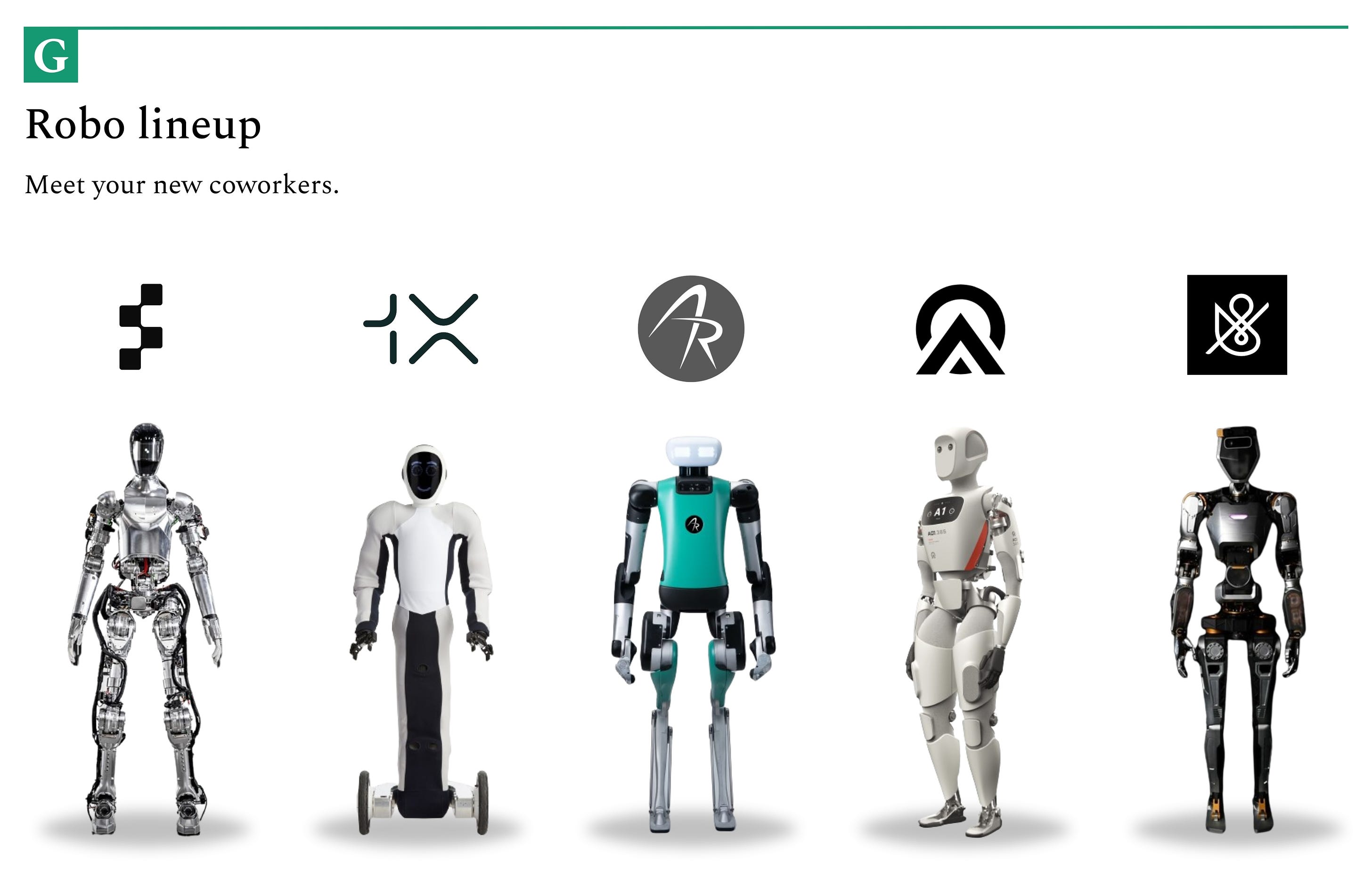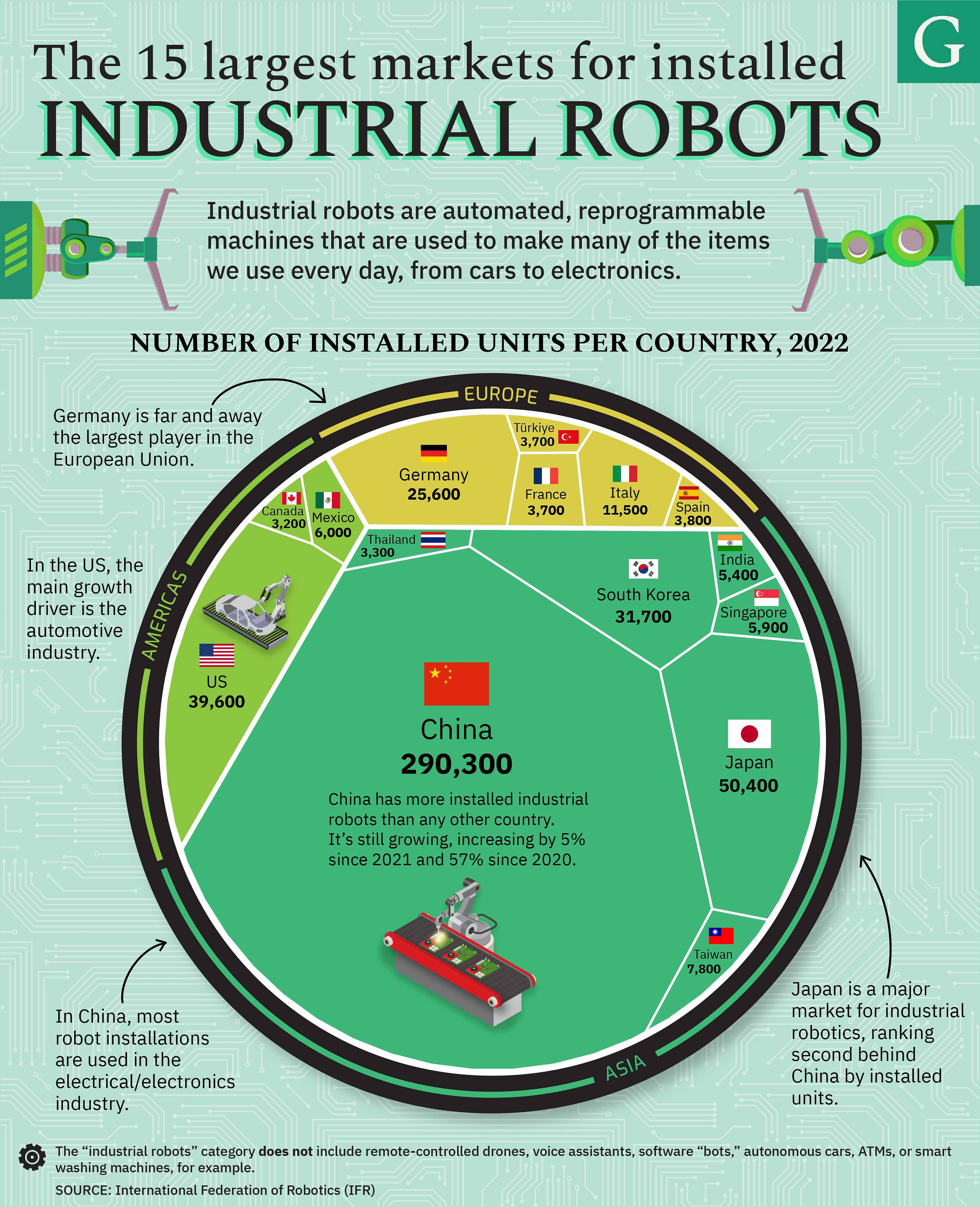Editor’s Brief: The Robotics Renaissance
Friends, Every once in a while, I spot something happening on tech’s frontline that I think more people should be paying close attention to. Something that has the potential to radically remake our world, change how we live, and – for the pragmatic investor – possibly deliver outlier returns. Traditionally, The Generalist hasn’t had a format to accommodate those ideas. We’re trying out an “Editor’s Brief” to fill that gap. It’s a short, sharp encapsulation of a trend or idea we consider important and that should better equip you to meet the future with a prepared mind. This is an experiment, so if you end up loving or loathing today’s email – please let me know! If you have a friend who should know about this topic, feel free to forward this email to them. A small ask: If you liked this piece, I’d be grateful if you’d consider tapping the ❤️ above! It helps us understand which pieces you like best and supports our growth. Thank you! Brought to you by AirwallexAirwallex was built with a single purpose in mind – to create a world where all businesses can operate without borders and restrictions, and by doing so, propel the growth of the global digital economy. With our proprietary infrastructure, we take the friction out of global payments and financial operations, empowering businesses of all sizes to unlock new opportunities and grow beyond borders. Over 100,000 businesses globally including brands such as Brex, Rippling, Navan, Qantas, SHEIN, and many more use our software and APIs to manage everything from global payments, treasury, and spend management to embedded finance. For more information on how Airwallex can help you simplify your global payments and financial operations, get in touch with our team today. Read The Generalist’s full deep dive on Airwallex here. Editor’s Brief: The Robot Population BoomWe are entering a robotics renaissance. Over the next decade, intelligent, embodied androids will permeate industrial activities and aspects of everyday life, from assembling cars to folding laundry. The impending robot “population boom” is the result of technological breakthroughs, intense investor appetite, labor cost arbitrage, and long-standing demographic trends. Why is this happening?Modern AI models have changed the game The same deep learning and neural techniques that have powered the generative AI revolution are helping robotics overcome one of its major limitations: a lack of training data. In the past, if you wanted to teach a robot to pick up a yellow block and place it in a blue bin, it had to learn through trial and error or extensive videos. New foundation models allow robots to learn from online text, images, and videos. Generative AI can create new data to tackle edge cases One of the challenges of operating in the physical world is the sheer volume of strange, niche possibilities. While AI thrives in decoding the fixed rules of chess or language patterns, it has historically struggled to account for real-world edge cases. Not only do new models help with this kind of “thinking,” they can also create new, relevant data to train on. Researchers can effectively train robots on visual scenarios created by generative AI. Investors are looking for the next bonanza Venture capitalists have aggressively invested in AI over the past few years, pouring billions into companies making new foundation models or building applications on top of them. As some of those well-capitalized startups close their doors, there is a growing itch to find the next great AI opportunity. Robotics is the beneficiary. Robots aren’t that fussy about pay A recent MIT study attempted to paint a rosy portrait of AI’s impact on the workforce by saying “only” 23% of wages paid would be “economically viable” to automate. That’s a lot! That figure will only increase as hardware costs decline and robots become increasingly intelligent. California’s decision to raise the minimum wage for fast food workers to $20 an hour and other similar initiatives may accelerate the shift. Major economies lack sufficient working humans America doesn’t have a large enough working-age population to support its young and elderly. The increase in the US’s “dependency ratio” is not unique – many other advanced countries face similar slumps. While immigration is one solution, robots are another. What can new robots do?Google’s RT-2 model best demonstrates what this new class of robotics is capable of. When an engineer prompted Google’s test robot to select the “extinct animal” from a range of dollar store figurines it had never seen before, it correctly selected a plastic dinosaur. The model’s ability to adapt to a new environment with new variables, generalize, and reason is novel and opens up huge possibilities. Modern robots are no longer constrained to a narrow pre-programmed problem. Above: Google's RT-2 in action (Google) Beyond RT-2, a range of robotics makers are demonstrating commercial utility across sectors from logistics to manufacturing to construction. Who are the major players?Google’s cutting-edge RT-2 model demonstrates the search monolith’s impressive AI research bonafides. Its DeepMind division is driving the technology forward and will continue to play a vital role. While we wouldn’t expect Google worker robots any time soon, autonomous vehicle subsidiary Waymo illustrates how the company applies artificial intelligence in the physical world. OpenAI disbanded its robotics division in 2021, citing a lack of progress. It remains an important player in the space, investing in startups like Figure and Physical Intelligence. After being cut loose, OpenAI’s robotics team founded Covariant, a maker of a robotics “brain” and physical setups for sorting items, assembling them into kits, and more. Amazon is a long-time customer and acquirer in the robotics space. After acquiring Kiva Systems for $775 million in 2012, the firm created a dedicated Amazon Robotics division that has continued investing in the space and trialing new solutions. Amazon is conducting one such trial with Agility, maker of the “Digit” humanoid robot, which it touts as “the first human-centric, multi-purpose robot made for logistics work.” Agility seems confident there’s demand for its products, announcing a plan to produce 10,000 per year via a new “RoboFab” in Oregon. Tesla’s “Optimus” robot attracted skepticism when first unveiled, but it seems to be improving quickly. Earlier this year, Elon Musk shared a video of Optimus gently folding a shirt, displaying its dexterity. On a recent earnings call, Musk said he expected Optimus to be operational in Tesla’s factories before the end of the year and available for purchase by 2025. (Musk’s timelines are not always the most reliable.) Given Musk’s gift for galvanizing technical talent to solve a hard problem, it would be foolish to underestimate his efforts.  Figure, 1X, Agility, Apptronik, and Sanctuary are all building humanoid robotics, some of which are finally ready to leave their home factory and find gainful employment. Figure’s 5’6 worker is headed to BMW’s production lines and, as mentioned, Agility is sending its units off to Amazon. Apptronik’s androids are slated for a longer journey: via a partnership with NASA, the company intends to send its robots to space to assist astronauts. What about Boston Dynamics? Though no one makes better sizzle reels of robot parkour, Boston Dynamics has struggled to find commercial applications for its dexterous machines. In many ways, they represent the pinnacle of old-world robotics: extremely well-tuned machines that struggle to generalize or solve new problems. Who else should you keep an eye on?Monumental is reversing the construction industry’s “productivity collapse” with non-humanoid robots. The Netherlands-based startup recently raised $25 million to develop its automated bricklayers further and disrupt this massive, sleepy industry. In the long run, Monumental hopes its technology will reduce housing costs and reignite the production of beautiful, well-crafted buildings. Above: Monumental's robo-brickie (Monumental) K-Scale Labs is building child-sized humanoid robots that cost as little as $8,000. To reduce the capital costs of spinning up an android army – necessary to gather data and improve its underlying model – K-Scale is outsourcing its hardware design so hobbyist engineers can build their own pint-sized assistants. It’s a clever approach that may help robotics develop the kind of vibrant open-source structure that has allowed AI models to improve rapidly.  Adagy Robotics illustrates the ancillary economy that may blossom around the robotics revolution. The Y Combinator startup functions as a kind of roadside assistance for robots, taking over malfunctioning machines. As robots proliferate, support services like Adagy may become increasingly important. Physical Intelligence recently raised $70 million to build a universal brain for robotics. Though its product is still under wraps, the startup has assembled a remarkable team, led by Karol Hausman, who co-authored Google’s original RT-2 research paper. Physical Intelligence intends for its software to be used across different form factors, making it the “ultimate generalist,” according to co-founder Lachy Groom. Open questionsShould robots look like humans? Many of the buzziest players in the space have chosen to build “humanoid” robotics. Though on the shorter and lighter side (usually around 5’5 and 130 pounds), they are recognizably human with legs, arms, and fingers. Are humans the optimal form factor? On the one hand, much of our world has been explicitly built for humans – if you design a robot that is too big, it might not be able to navigate existing doors, passageways, or vehicles. On the other, we have our limitations. If we had eight arms instead of two or forty fingers, what might we be able to accomplish? Will robots “evolve” into strange new form factors? AI can help design robots, as well as make them run. Recent research at Northwestern University showed how AI can create novel robot bodies when a clear goal is set. Asked to produce a specimen that can “walk,” the researcher’s AI model concocted a blob with squishy, irregular legs punctuated by seemingly random holes. It worked. Strangely, it struggled when the researcher tried to remove the holes from the design. The researchers dubbed this process “instant evolution.” It illustrates AI’s unique, occasionally inexplicable “creativity." Robots of the future may look more like an alien species than facsimiles of ourselves.  What is the best “robot-native” business model? Although hardware costs are declining, buying a robot outright is expensive. Will Amazon and other large customers choose to buy machines outright? Will they lease them similar to a car? Might they simply “hire” them, as you would any other worker? Or should robotics companies give them away for free, receiving a portion of the efficiency gains captured as recompense? The coming years will reveal which model best meets commercial realities. How does the robotics boom impact US-China geopolitical tensions? It’s unclear which superpower will benefit from the “demographic dividend” of a robotic population surge. As it stands, China leads the world in the number of installed industrial robots, with nearly 300,000. That’s over 7x more than the United States. However, the leading companies call America home. Given FBI Director Christopher Wray’s warning last week about China’s ability to cripple American infrastructure through technological means, it’s essential America captures this dividend and sets global standards. Is this a “productive bubble?” It’s too early to tell. But it looks like it could become one. If venture interest swells as expected, tens of billions of capital will flood the sector. While that might result in irrational valuations that experience a hard correction, it could also brute force progress. In particular, a bubble may drive production efficiencies (driving down the price to make a robot), increase the number of robots deployed (radically increasing available training data), and test the appropriate applications and form factors. When the bubble pops, we might be left with real progress: well-trained, low-cost robotics with clear commercial value. Downstream impactsHardware flourishes The robotics boom will breathe new life into hardware. As robots increase in capability, the number of possible form factors will increase, especially as we search for ideal use cases. We may have small, scuttering robots to clean our floors, monkey-like climbers to wash windows, and spindle-fingered spiders to rapidly sort packages. Even if humans prove to be the ideal wrapper, a range of configurations is possible, opening up a vast new design space. In many respects, it is another example of AI getting a “better body.” A different kind of “migrant” crisis One slightly provocative reading of the robot population surge is as a modern migrant crisis: an influx of new workers is emerging to Steal Our Jobs™. We expect some of the same rhetoric and pressure points to appear, exacerbating existing class tensions. While some displaced workers may be able to upskill and find better-paying and more desirable employment, others will struggle. Both public and private sector solutions will be needed to support those at the bottom of the pyramid. Better working conditions Robots are well-suited to tackle humanity’s most dangerous tasks. While that might result in the obsoletion of perilous career paths, on the bright side, it may also allow workers to avoid the worst parts of their existing jobs. We have already seen this play out in the military with drones and other automated assets, reducing human jeopardy. In the future, a similar approach may come to logging, steelwork, mining, and other high-risk vocations. Discovering “human-hostile” parts of the world Earth is the only planet we’ve found that can sustain life. However, that does not mean that every inch of it is conducive to humans. Parts of our pale blue dot are actively hostile to human life, reducing our ability to conduct research and better understand our world. Robots are not governed by the same physical limitations, making them better able to gather data in harsh conditions. In the not-so-distant future, robots may tread the ocean floor, discovering new natural resources and making fresh discoveries. If you liked this article, we think you’ll love Generalist+. Enjoyed this piece from The Generalist? Consider upgrading to our premium newsletter, Generalist+, for even more insights, exclusive interviews, and perspective-shifting articles. Subscriptions are just $22/month and unlock all past and present premium content. We recommend starting with one of our private correspondences with Reid Hoffman, Ho Nam, or Vinod Khosla. PuzzlerAll guesses welcomed and clues given to anyone that would like one. Just respond to this email for a hint.
Well done to Krishna N, Tyler W, Aris E, Michael O, Keith R, Emerson K, Michael B, Brandon W, Grant B, Bernardt V, Rafael K for guessing last week’s riddle correctly:
The answer? Prison. Other clever responses included: a book of stamps, a check book, or a printing press. Nicely done. Until next time, Mario You're currently a free subscriber to The Generalist. For the full experience, upgrade your subscription. |
Older messages
Working with The Olympians: Inside Traba’s Intense Culture
Sunday, April 21, 2024
The $200 million industrial staffing platform is disrupting a big, unsexy market. It's doing so with a work ethic that has captured attention and courted controversy. ͏ ͏ ͏ ͏ ͏ ͏ ͏ ͏ ͏ ͏ ͏ ͏ ͏ ͏ ͏
The Founders Guide to Listening to Your Customers
Tuesday, April 16, 2024
The systems and strategies to help you build a truly customer-centric organization. ͏ ͏ ͏ ͏ ͏ ͏ ͏ ͏ ͏ ͏ ͏ ͏ ͏ ͏ ͏ ͏ ͏ ͏ ͏ ͏ ͏ ͏ ͏ ͏ ͏ ͏ ͏ ͏ ͏ ͏ ͏ ͏ ͏ ͏ ͏ ͏ ͏ ͏ ͏ ͏ ͏ ͏ ͏ ͏ ͏ ͏ ͏ ͏ ͏ ͏ ͏ ͏ ͏ ͏ ͏ ͏ ͏ ͏ ͏
Letters to a Young Founder: Vinod Khosla
Tuesday, April 9, 2024
The founder of Sun Microsystems and “venture assistant” talks about his childhood, early inspirations, and the making of a legendary entrepreneur. ͏ ͏ ͏ ͏ ͏ ͏ ͏ ͏ ͏ ͏ ͏ ͏ ͏ ͏ ͏ ͏ ͏ ͏ ͏ ͏ ͏ ͏ ͏ ͏ ͏ ͏ ͏
The Founders Guide to Optimizing Your Fundraise
Tuesday, March 26, 2024
Eight elite founders share the tactics and frameworks that helped them raise over $4 billion in venture funding. ͏ ͏ ͏ ͏ ͏ ͏ ͏ ͏ ͏ ͏ ͏ ͏ ͏ ͏ ͏ ͏ ͏ ͏ ͏ ͏ ͏ ͏ ͏ ͏ ͏ ͏ ͏ ͏ ͏ ͏ ͏ ͏ ͏ ͏ ͏ ͏ ͏ ͏ ͏ ͏ ͏ ͏ ͏ ͏
Letters to a Young Investor: Ho Nam
Tuesday, March 19, 2024
We're kicking off a new season with one of venture capital's great practitioners, the backer of grand slams like Roblox and Coupang, and the co-founder of Altos Ventures. ͏ ͏ ͏ ͏ ͏ ͏ ͏ ͏ ͏ ͏ ͏
You Might Also Like
[CEI] Chrome Extension Ideas #180
Tuesday, March 4, 2025
ideas for Figma, GitHub, Job Applicants, and stud ͏ ͏ ͏ ͏ ͏ ͏ ͏ ͏ ͏ ͏ ͏ ͏ ͏ ͏ ͏ ͏ ͏ ͏ ͏ ͏ ͏ ͏ ͏ ͏ ͏ ͏ ͏ ͏ ͏ ͏ ͏ ͏ ͏ ͏ ͏ ͏ ͏ ͏ ͏ ͏ ͏ ͏ ͏ ͏ ͏ ͏ ͏ ͏ ͏ ͏ ͏ ͏ ͏ ͏ ͏ ͏ ͏ ͏ ͏ ͏ ͏ ͏ ͏ ͏ ͏ ͏ ͏ ͏ ͏ ͏ ͏ ͏ ͏ ͏ ͏ ͏
500k subs & 7 figs in revenue
Tuesday, March 4, 2025
This founder was still in college when he sold the business ͏ ͏ ͏ ͏ ͏ ͏ ͏ ͏ ͏ ͏ ͏ ͏ ͏ ͏ ͏ ͏ ͏ ͏ ͏ ͏ ͏ ͏ ͏ ͏ ͏ ͏ ͏ ͏ ͏ ͏ ͏ ͏ ͏ ͏ ͏ ͏ ͏ ͏ ͏ ͏ ͏ ͏ ͏ ͏ ͏ ͏ ͏ ͏ ͏ ͏ ͏ ͏ ͏ ͏ ͏ ͏ ͏ ͏ ͏ ͏ ͏ ͏ ͏ ͏ ͏ ͏ ͏ ͏ ͏ ͏ ͏
1,000,000
Tuesday, March 4, 2025
Taking a moment to celebrate and reflect—and then back to work ͏ ͏ ͏ ͏ ͏ ͏ ͏ ͏ ͏ ͏ ͏ ͏ ͏ ͏ ͏ ͏ ͏ ͏ ͏ ͏ ͏ ͏ ͏ ͏ ͏ ͏ ͏ ͏ ͏ ͏ ͏ ͏ ͏ ͏ ͏ ͏ ͏ ͏ ͏ ͏ ͏ ͏ ͏ ͏ ͏ ͏ ͏ ͏ ͏ ͏ ͏ ͏ ͏ ͏ ͏ ͏ ͏ ͏ ͏ ͏ ͏ ͏ ͏ ͏ ͏ ͏ ͏ ͏ ͏
BSSA #116 - Outsourcing to scale 🚀
Tuesday, March 4, 2025
March 04, 2025 | Read Online Hello everyone! The Wide Event is almost sold out. More than 90% of the tickets have been booked. If you're one of the people waiting until the last minute to purchase,
🔥 The secret factories big brands don’t want you to know 👗👖
Tuesday, March 4, 2025
The best fashion suppliers don't advertise—here's how to find them. Hey Friend , If you've ever struggled to find high-quality fashion manufacturers, there's a reason: The best
Making Wayves
Tuesday, March 4, 2025
+ Girls just wanna have funding; e-bike turf war View in browser Powered by ViennaUP Author-Martin by Martin Coulter Good morning there, Since 2021, VC firm Future Planet Capital (FPC) has secured more
Animal Shine And Doctor Stein 🐇
Monday, March 3, 2025
And another non-unique app͏ ͏ ͏ ͏ ͏ ͏ ͏ ͏ ͏ ͏ ͏ ͏ ͏ ͏ ͏ ͏ ͏ ͏ ͏ ͏ ͏ ͏ ͏ ͏ ͏ ͏ ͏ ͏ ͏ ͏ ͏ ͏ ͏ ͏ ͏ ͏ ͏ ͏ ͏ ͏ ͏ ͏ ͏ ͏ ͏ ͏ ͏ ͏ ͏ ͏ ͏ ͏ ͏ ͏ ͏ ͏ ͏ ͏
upcoming analyst-led events
Monday, March 3, 2025
the future of the customer journey, tech M&A predictions, and the industrial AI arms race. CB-Insights-Logo-light copy Upcoming analyst-led webinars Highlights: The future of the customer journey,
last call...
Monday, March 3, 2025
are you ready? ͏ ͏ ͏ ͏ ͏ ͏ ͏ ͏ ͏ ͏ ͏ ͏ ͏ ͏ ͏ ͏ ͏ ͏ ͏ ͏ ͏ ͏ ͏ ͏ ͏ ͏ ͏ ͏ ͏ ͏ ͏ ͏ ͏ ͏ ͏ ͏ ͏ ͏ ͏ ͏ ͏ ͏ ͏ ͏ ͏ ͏ ͏ ͏ ͏ ͏ ͏ ͏ ͏ ͏ ͏ ͏ ͏ ͏ ͏ ͏ ͏ ͏ ͏ ͏ ͏ ͏ ͏ ͏ ͏ ͏ ͏ ͏ ͏ ͏ ͏ ͏ ͏ ͏ ͏ ͏ ͏ ͏ ͏ ͏ ͏ ͏ ͏ ͏ ͏ ͏ ͏ ͏ ͏
🦄 Dimmable window technology
Monday, March 3, 2025
Miru is creating windows that uniformly tint—usable in cars, homes, and more.




